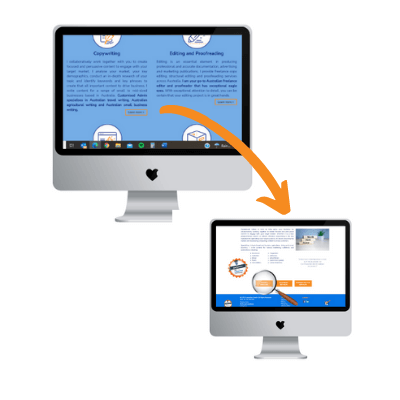Here is a guide to help you structure your new business website
When I commenced my new small business I knew that I would need a website. I’d never built one before but knew that I wanted to try and build it myself.
I did a lot of research and taught myself. Let me say, it doesn’t happen overnight. I made a basic website to get up and running. Since then I continue to build on to the site as I learn more and my business evolves.
Let’s take you through a guide on how to structure your own website including the important pages needed as a starting point.

What pages should I include on my website?
To start any new website there are several key pages to include. These are a home page, about page, services page and a contact page. The main idea of a small business website is to inform visitors to you site about who you are, what your business offers and how to get in contact with you for further information. The aim is for your website to stand out and attract potential customers.
Your website should include a clear header which will appear at the top of each page. This should include your logo, business name, navigation menu and your social media icons. Use your brand colour palette and make sure the font stands out on the background. If using a dark colour, use a light coloured font.
Likewise a footer at the bottom of each page which includes your copyright with ‘all rights reserved’, privacy policy, website terms of use, disclaimer, ABN, contact details, your social media icons and a brief menu of your services for easy access.

A privacy policy is essential when taking contact details and any personal information, particularly payments for goods and services. And it’s a wise idea to have terms and conditions to help protect you from any legal action. A disclaimer with a copyright paragraph helps protect you against ‘copycats’. The last thing you want to see is your images, logo and content replicated elsewhere.
What should be on my home page?
The home page is usually the first page a reader will see. It’s important to capture their attention and reel them in to reading on. You want to give an overview of who you are, what your business does and why your business stands out from your competitors. The ‘who, what, why’ of your business. It is like a synopsis of a book – a summary of what’s in your website capturing your overall business in a snapshot.

A call to action button offers a reader to contact you straight away without reading your other pages. This button should stand out and be easily identifiable. An effective way to do this is to use the main pop colour in your branding. Say you have blue and orange as your main colours, it would be ideal to use the orange. Orange is also a warm colour so can often be seen as inviting. After all that’s what you want – your reader to contact you.
My 'about' page
Your about page gives the reader a background on your business and yourself as the owner. You may have a team working for you and this is a good place to introduce them. Readers like to see faces of who they will be dealing with.
Write a blurb on yourself and each staff member. Include a head shot of each staff member and their position title. For a sole trader you will only have the one headshot and you can include more information on yourself. Include past work experiences and qualifications. You can even add a personal note about hobbies, music or sport to help build a connection.
How should I structure my services or product page?
The services page is a dedicated page to showcase all your services and products. You can present them in various ways including a grid, list or boxes. Make sure the reader can easily identify each service or product and it’s easy to read.
For a services page you need to give an overview of what you offer. It is also a good idea to create a sub page for each service so that you can elaborate further on what you offer. On each sub-page have a button that links to the other services provided.

If your business is an e-commerce business, then this page can be your ‘products’ page. Make sure you include an image, description and relevant specifications (if required). People like to see an image of what they are buying – I certainly do.
You may sell furniture, so specifications and measurements are essential. An accommodation provider will need to include some photos of the room along with bedding configurations and what facilities are in the room. A tour provider would need to include information on each tour including times and pricing. So as you can see it depends on what products you sell as to what to include.
What should be on my contact page?
The contact page – a very important one. After all you want people to contact you. This page should include all the necessary contact details for your business including:
- phone number
- email address
- website address
- address (required if customers come to your place of business)
You should also include a contact form. The various website platforms that are out there in the market offer a customisable contact form. A visitor to your site can easily fill out this form with their contact details and a brief message to you. Make sure you include a tick box to agree to terms and conditions.

Are there other pages I should consider?
Yes, there are other pages that you can include depending on what kind of business you operate. These can be a work in progress and can be built as you evolve your business.
- Portfolio page – this is where you can showcase previous work. Examples of previous work shows potential clients what you can do. This may include portable logos, document format (PDF) documents, photo galleries or links to other websites.
- Testimonials page – everyone loves to see great feedback from past clients. It is on this page that you can showcase to the world your positive reviews.
- Blog – this is where you write informational articles for readers that are relevant to your business or industry. It’s a tool used to boost audience engagement and help with Google ranking.
Any page that you include should be mobile friendly. Mobile usage is huge today – people want answers on the go. The worst thing you want is having a smick looking website but the text cuts off when viewed on a mobile device.
How can I make my website effective?
Having an online presence is a great asset for your business. It is even a greater asset if the website works the way you want it to and do what it is supposed to do. It needs to be effective.
There are important characteristics not to be overlooked when building your new website. All websites should be:
- findable – your audience need to be able to easily find what they are looking for whether it’s a certain piece of information or a button to take them to another page in your website.
- readable – the font needs to be large enough to clearly read, headings should be clear and separate from body text and the use of dot points breaks up big slabs of content. Using white space (spacing out your content) is an effective way of helping the reader absorb each section of information.
- understandable – write content in a way that is easy to understand and digest.
- actionable – call to action buttons (contact me, chat with me, send me an email) need to be easily found. That’s where you want the reader to end up – contacting you.
- branded – it is very important for brand identity to keep your website uniformed and consistently styled. Only use a few colours (colours that are in your logo) and font styles. Too many colours and fonts make your website look too busy and clumsy. It is imperative to keep this branding and design consistent throughout the whole website.
A visitor to your website should be able to easily navigate their way around your site linking from page to page like a jigsaw puzzle. If a person cannot find what they are looking for, you will lose them very quickly.
Over to you
What have you learnt about building a website for a new small business? Are you ready to take the next step and build your website? Do you need help from a copywriter with writing your content? If you liked this article, please share and if you have any questions, please get in touch.
If you would like more information, please send an email to crystal@crystallobbancreative.com.au or fill in the contact form here.

